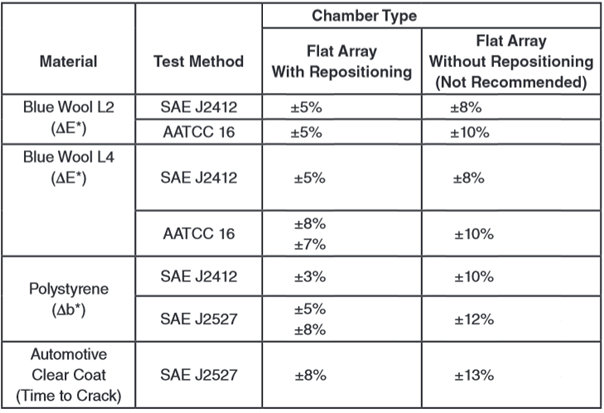Weathering test standards often include guidance on repositioning of test specimens. This is the practice of moving specimens to different locations within a test chamber over the course of a test. Q-Lab considers specimen repositioning a best practice when performing weathering testing, in order to ensure the most repeatable results regardless of chamber uniformity or tester type.
Repositioning in standards
Depending on the test standard, repositioning can be included as either a mandatory requirement, a recommended practice, or even something in between, where repositioning is mandatory only if certain uniformity conditions cannot be met. Over time the major lightfastness and weathering test standards have taken a more favorable view of specimen repositioning.
- ISO 105 B02, “Colour fastness to artificial light: Xenon arc fading lamp test,” published in 1984, offers a nonmandatory comment that repositioning is recommended.
- ASTM G151, “Standard Practice for Exposing Nonmetallic Materials in Accelerated Test Devices that Use Laboratory Light Sources,” published in 1997 and first revised in 2000, requires repositioning below 90% irradiance uniformity and recommends in all cases.
- ASTM D7869, “Standard Practice for Xenon Arc Exposure Test with Enhanced Light and Water Exposure for Transportation Coatings,” from 2013, always requires specimen repositioning.
Why does Q-Lab advocate specimen repositioning?
Q-Lab’s advocacy for specimen repositioning is supported by data. In a round robin study, documented in LX-5024 “Rotating and Static Xenon Testers Compared,” data was collected to demonstrate the differences in test uniformity with and without repositioning. Table 6 from that study, reproduced in a modified form below, demonstrates substantial improvement in test result uniformity with repositioning.
The language in test standards tends to have an improper focus on irradiance uniformity. Specimen repositioning is critical to improve testers’ delivery of all weathering factors, including water spray, humidity, and temperature. Therefore, in order to ensure optimum test repeatability, Q-Lab strongly supports specimen repositioning in all lightfastness and weathering tests.

